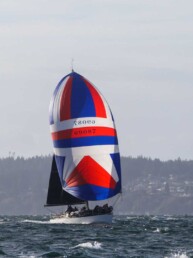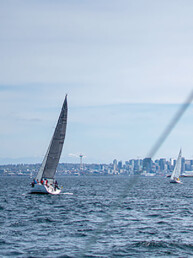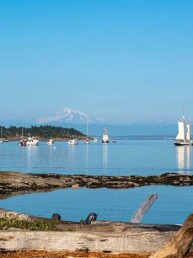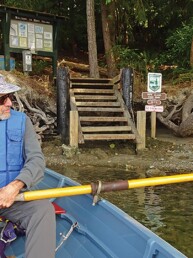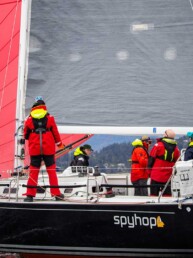It was April when I consciously admitted it: I’d made a mistake buying that old Rawson 30 I called Tortuga. It would be 10 years before I could set off to circumnavigate the globe solo in that piece of work (a dream I began writing about for 48° North in December 2018). It had so many problems, including its shot engine that needed total replacement, which looked particularly dire with the jagged rusty aluminum of a partially cut-out fuel tank towering beside it.
I’d done hundreds of hours of work on that boat, and I’d have to do several thousand more before she could be trusted in heavy weather. And here I was, puttering away, snatching two to three hours per week to paint the cabin white with red accents. I was taking a break from structural work, like re-coring decks, to do an aesthetics-based “peace of mind” project.
The wood was in such terrible shape it harmed my state of mind just to glance at all the carelessly drilled holes, the lack of corner edging to separate the bulkhead from the adhesive-caked fiberglass where its moldy vinyl wall coating had been partially ripped off. There was a stark line of discoloration along the bottom of the settee and companionway stairs, indicating the boat had once flooded.
Most of all, I was sick of driving several five gallon buckets of stinky, greasy water to the hazmat station every time the four massive, inaccessible, potholed cement bilges filled with rain water from the leaks I had no time to locate. Even the professionals in Tyvek suits were beginning to grumble that they had to whiff that putrid rainbow sheen again. No matter how many times I went at the bilge with a steam cleaner, it made little difference.
I was working 80 hours per week between two-and-half jobs and, to avoid paying rent, I lived in my childhood bedroom. I had money coming in but nearly zero time; and I would much rather buy a better boat than slave away on this one. I wouldn’t even be in love with Tortuga if she were fixed up. No amount of fixing would mean I could sit up in the V-berth while sleeping at port.
Alas, I set out on my quest for the right boat by scouring YachtWorld, Craigslist, Facebook and 48° North. I looked at two Ingrid 38s. One seemed to be in great condition with a beautiful new Beta Marine engine, but was severely underpowered. Deal breaker! The other had gorgeous interior woodwork but reeked of big projects: the three potable water tanks were fiberglass painted white inside, with undrinkable water, and could not be removed from the keel. The bilge had black oil in it. The engine was a giant Mercedes from the 1960s — too old. And being a kit boat, who knew if the bulkheads had been tabbed correctly.
Seeing them in person, I realized a boat of that size was too much for me anyway. I wouldn’t be able to handle it without significant mechanical advantage; and both multi-speed winches and higher slip fees would add cost. Every problem would be a bigger problem to fix, which could add years to my departure timeline.
I tried to buy a Wauquiez Gladiateur 33, a fast, fin-keeled French bluewater boat. It had a spotless 2005 Volvo with sail drive and the keel bolts were shiny stainless. I loved the beefy brass sink fixtures and the spacious galley. I wasn’t sure how I could store stuff in the open cubbies behind the settees without it flying all over, but whatever — a small issue that must have a quick fix, like bungee cord or netting.
Before I could get a survey, the financing fell through. Though disappointed, I was putting away money so fast I could just afford to pay cash for something really nice in less than a year anyway.
Like many people have done, I fell in love with the idea of the Pacific Seacraft Dana 24. It had a symmetrical open plan layout, it was so fat and beamy, and they all had Yanmar 2GM20Fs, which I was familiar with from my first boat. It was utterly charming that this tiny, heavy tank was a serious bluewater boat. Why do I need bigger? It was an expensive little gem — $50k on average — but for a boat in the 35 to 40-foot range the same price would get me something older and in worse condition. Quality over quantity, I decided.
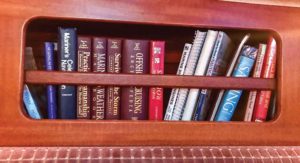
I listed my layout preferences: the bookshelf with cabinets on both sides of it, the same on both sides of the cabin; I could hold out for a post-1989 Dana, with a dedicated propane locker in the cockpit and a hull laid with vinylester resin instead of polyester. I found a photo of a partially built Dana that showed all the storage compartments, and with my Apple Pencil I superimposed a list of where all my essential gear would go, to make sure I could fit everything.
I began sailing with a new friend, Carol, who owned a Dana 24 in Olympia. The boat tracked beautifully, it was incredibly course-stable and heavy like a ship, while not being noticeably too slow. It seemed fast compared to Tortuga, which was slower on the PHRF scale — 268 to the Dana’s 243.
A few months passed and I sold the Rawson for $5,000 two days after I listed it. To answer a question I am often asked, I do not regret asking so little. It would only have been a few thousand more and not worth the headache of longer time on the market — potentially the entire winter. I had removed all the higher end gear that wasn’t essential to basic functioning, but I did leave that almost new outboard I installed when my pink Volvo had failed at Seymour Narrows.
In September, while recovering from a major surgery, I watched hundreds of episodes of YouTube sailing channels. I yearned to get out on the water soon and I wanted a nice boat that could get me there. These channels led me to the conclusion that the Dana was more hyped up and expensive than necessary, and it would still take me two years to afford. I could find a good boat for less that would do the job just as well, with maybe a bit more space.
I had been eyeing a Hallberg-Rassy Monsun 31 on YachtWorld since May, located at McCuddy’s Marina in Portland. It was a renowned bluewater model. One man had singlehanded his around the world three times, including Cape Horn. Others were currently sailing one through the pack ice of the Northwest Passage. They were built to withstand any environment and even running aground, with one-inch-thick fiberglass in the keel. And yet they were light for full keel boats, with a PHRF rating of only 201! It was like the best of both worlds.
The Monsun on YachtWorld had started at $40,000, and now it was down to $35,000. I had managed to save $20,000 since March. My mom said if I could find a nice boat that was a little out of my budget, she would loan me $10,000-15,000 from the family savings — but she urged me to try to offer low.
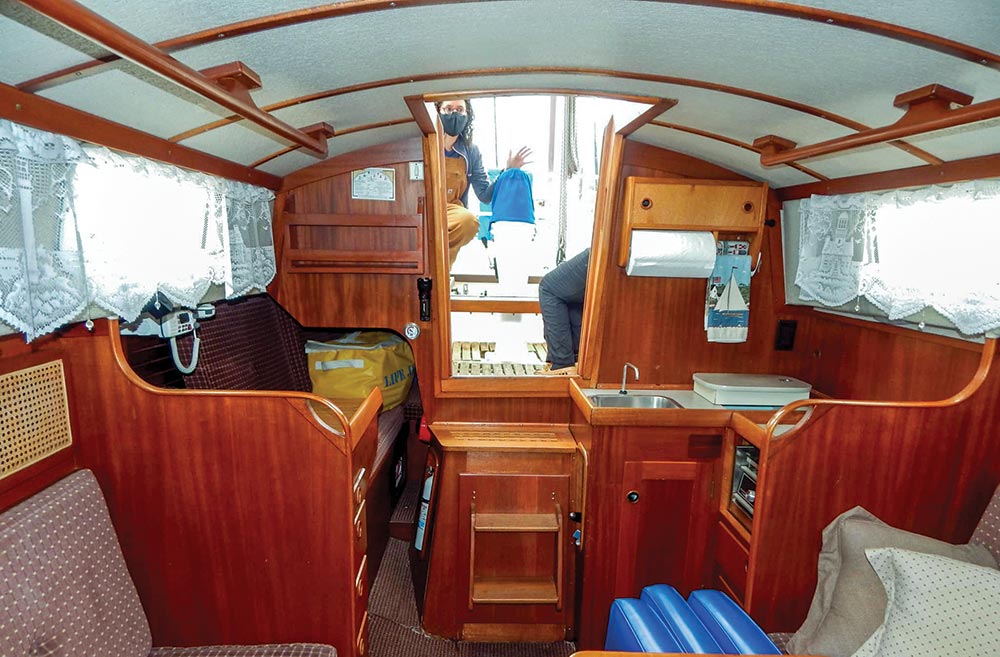
I drove down to Portland in thick smoke from the forest fires, careful to use only recycled air and to close my car door quickly after getting out at the rest stop. When I got to the boat, one of the first things I discovered was that, not only could I sit up in the V-berth, I could also look out the skylight at the stars. It had the most gorgeous interior woodwork of any boat from the 1970s I’d ever seen: hand rubbed mahogany, treated to a silk finish. It had the cabin layout I’d sought in the Dana 24 with the bookshelf wedged between cabinets on both port and starboard. The storage was well organized. The wardrobe had both shelves and a hanging locker, and the chart table had lots of little drawers so I wouldn’t have to pile stuff in a deep locker. Best of all, in the engine room there was a shiny Universal 25XP from 2008, with less than 100 hours on it. And the transmission had been installed new in 2018.
I offered $27,000 and the seller countered $31,000. I appreciated that he was trying to meet me in the middle, and since it had started at $40,000 I accepted. The survey process began and I vowed to do everything right this time. I hired Pat from A. Mazon and Associates to do the survey because they have a solid reputation in the Portland area — feared by brokers and loved by buyers. When the sea trial revealed a mystery of fluctuating RPMs, I even got a separate engine inspection. The inspection showed no major issues and the RPMs were steady, meaning it was probably debris that had been stirred up in the 35-gallon diesel tank encapsulated in the keel. All the older Hallberg-Rassys had them; but then, all the newer HRs had teak decks — a trade off I guess. I accepted that I might just have to go in and clean that tank under the engine one day. Meanwhile, it would be easy to put in a day tank. I would want to do that even if the main tank were clean, since I’d like to have a 60 gallon capacity for ocean crossings.
The whole closing process took about two months. After that, I had the boat trucked to Olympia — where I did the bottom paint — and then I sailed it to Seattle. It sure was fast for a full keel boat! In spite of the iron ballast, she was going 6.5 knots on the mainsail alone for most of the day.
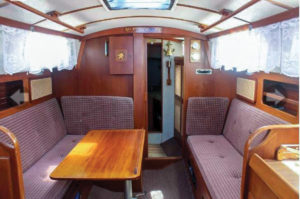 The first thing I did when I arrived in Seattle was put on the nearly new full winter cover to protect that teak cap rail and the teak slatted cockpit grating during the rainy season. Since I have a 36-foot slip, I plan to store my 13-foot MiniSail racing dinghy in front of the boat so I can sail the MiniSail while I prepare the Monsun for liveaboard. Those preparations include finally using the Wallas forced air diesel heater I purchased that has been waiting to be installed on the right boat for more than three years. I also need to upgrade some components of my propane stove system. Then in March, when the winter cover comes off, I can switch over to sailing the Monsun more.
The first thing I did when I arrived in Seattle was put on the nearly new full winter cover to protect that teak cap rail and the teak slatted cockpit grating during the rainy season. Since I have a 36-foot slip, I plan to store my 13-foot MiniSail racing dinghy in front of the boat so I can sail the MiniSail while I prepare the Monsun for liveaboard. Those preparations include finally using the Wallas forced air diesel heater I purchased that has been waiting to be installed on the right boat for more than three years. I also need to upgrade some components of my propane stove system. Then in March, when the winter cover comes off, I can switch over to sailing the Monsun more.
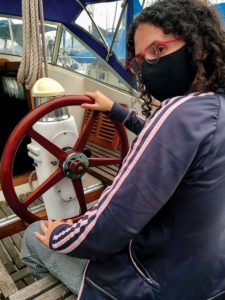 I plan to attempt a solo trip around Vancouver Island again in the summer of 2022. I can’t take any major trips until I finish paying my mom back — which will hopefully be around the end of this summer — and I don’t want to be in a rush. Part of what sabotaged me with Tortuga was just that: the rush to buy a bluewater boat, without an official survey, thinking I’d have the energy to fix everything myself in a timely manner. That rush to get going by a deadline in August 2019 made me cut corners installing things right, such as putting my exhaust thru-hull too high, which caused my engine to flood with water. It’s the same mentality that would cause one to forget to clip in a tether one day while singlehanding offshore, because they just had to go take care of something on deck right that second. And then a rogue wave hits.
I plan to attempt a solo trip around Vancouver Island again in the summer of 2022. I can’t take any major trips until I finish paying my mom back — which will hopefully be around the end of this summer — and I don’t want to be in a rush. Part of what sabotaged me with Tortuga was just that: the rush to buy a bluewater boat, without an official survey, thinking I’d have the energy to fix everything myself in a timely manner. That rush to get going by a deadline in August 2019 made me cut corners installing things right, such as putting my exhaust thru-hull too high, which caused my engine to flood with water. It’s the same mentality that would cause one to forget to clip in a tether one day while singlehanding offshore, because they just had to go take care of something on deck right that second. And then a rogue wave hits.
I finally have a nice boat, and I am going to protect it and myself. I will patiently add to it until I feel relaxed and ready to go. When I can afford to take time off from my jobs, I will seek out opportunities to get that heavy weather ocean sailing experience I still lack. A crew spot on a yacht delivery to Hawaii, maybe? We’ll see. Regardless, I’m a lot closer to my dream today than I was at this time last year.

